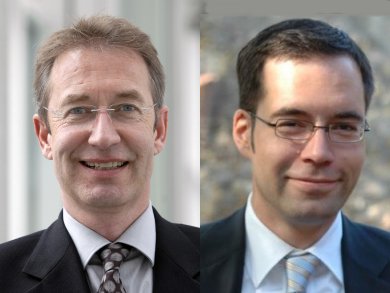Organic chemistry has been the basis for drug discovery since its beginning. First, the invention of fundamental lab techniques allowed the purification and analytical characterization of the pure chemical ingredients of natural remedies for which pharmacological acitivities had been known for ages, e.g., morphine (first isolated in 1804), atropine (1831), digitoxin (1862). With the rising knowledge in organic chemistry over the course of the nineteenth century, the first synthetic drugs were invented, some of which are still being widely used today, e.g., aspirin®, glyceryl trinitrate, phenacetin, as well as acetaminophen. Since then, organic chemistry, through medicinal chemistry as its specialization for the discovery of small-molecule drugs (SMOLs), has had a continuously larger impact on an ever increasing number of disease areas, successfully improving human health.
With the introduction of the first protein drugs, the possibility to create antibodies for therapeutic purposes, and the hype over gene therapy in the 90s, came the first notions that SMOLs would eventually be replaced by more biological approaches. In the meantime, several of these new treatment options have been very successful, e.g., substitution therapy with proteins like erythropoetin or factor VIII, or antibodies for the treatment of cancers or inflammatory diseases. A plethora of novel treatment modalities are under development that complement these approaches, including antibody–drug conjugates, antibody mimetics, siRNA- and miRNA-based treatments, aptamers, cell therapies, etc. This, together with the notion that productivity in pharmaceutical research and in particular SMOL research is declining, led to the suggestion that medicinal chemistry should focus more on the modification and chemical manipulation of larger systems, and place its stake in the field of chemical biology. While this certainly makes sense in order to broaden the impact of chemistry – in the end all biology has chemistry as its basis – we want to make a case for the future of SMOLs in drug discovery.
1. There is still a very high unmet medical need for new drugs in general
Experts estimate that approximately 8,000 potential drug targets exist for SMOLs and protein/antibody therapeutics in the human genome. So far, about 300 are addressed by drugs on the market or in late clinical development. Although the impact these drugs have had on mortality and morbidity is already impressive, there are many disease areas that have limited or no treatment options. Included among these are stroke, sepsis, heart failure, many cancer types, atrial fibrillation, cystic fibrosis, as well as Alzheimer’s and other geriatric diseases, to mention just a few.
2. SMOLs continuously broaden their target scope
SMOLs continue to be successful today: >70 % of all blockbuster drugs with annual sales over 1 billion US dollars in 2009 were SMOLs. Tremendous progress with SMOLs has been made in several areas by addressing novel target classes: HMG-CoA-Reductase in lipid disorders (e.g., Lipitor®), kinases in oncology (e.g., Gleevec®, Nexavar®), HIV protease in antiviral therapies (e.g., Nelfinavir, Tipranavir), and the protease FXa in thrombotic disorders (e.g., Xarelto®).
SMOLs have been discovered not only as inhibitors but also as activators of enzymes: The most prominent example is riociguat, a stimulator of the soluble guanylate cyclase (phase III, pulmonary hypertension). During the last decade, many efforts have been made to systematically address a specific class of targets that was previously judged as non-druggable, namely protein-protein interactions. Small molecules have been discovered that bind with drug-like potencies to ‘hot spots’ on the contact surfaces thereby preventing protein-protein interactions. Two examples are the nutlins, inhibitors of the MDM2/p53 inhibition and ABT-263, a SMOL which interferes with the interaction between anti- and pro-apoptotic Bcl-2 proteins (phase II, several cancer types). Currently, many of these intracellular targets can only be addressed with SMOLs, thereby offering opportunities for innovative therapies.
3. SMOLs offer several unique therapeutic advantages
SMOLs hitting the same target can be designed for oral as well as intravenous administration. Oral dosing is more convenient for many chronic applications. Intravenous applications are often needed for acute treatments, as this route can allow a faster onset of drug action. SMOLs can address extra- and intra-cellular targets and they can be designed to pass through the blood-brain barrier. Precise adjustment of the duration of drug action as well as of inhibitory or stimulatory effects is achievable.
4. SMOLs can help to reduce overall healthcare costs
Despite the obvious need for increased efforts to discover innovative therapies, the drug discovery community is under more and more pressure to reduce costs and increase efficacy from a society that wants rapid access to the best treatment, payors who have to make difficult choices faced with limited budgets but increasing healthcare demands, and regulatory bodies who have to balance risk against benefit. In addition to the above mentioned advantages, small molecules can be administered orally, which lowers treatment costs based on a less demanding infrastructure, and are produced in less costly and complex production facilities. More patients can be treated per dollar/euro spent.
Taking all these arguments into account, it should be clear that future innovation in small-molecule drug discovery is a must for industry as well as for society. For the benefit of the patients, we have to leverage the full potential of all approaches for the treatment and the prevention of diseases, including biologicals and novel treatment paradigms that are still on the horizon (e.g., siRNA/miRNA-related treatments). SMOLs will continue to play a very prominent role in this context, as will medicinal and organic chemistry as their main driving force.
 Professor Dr. Hanno Wild is Head of Global Lead Generation and Optimization within Global Drug Discovery at Bayer HealthCare Pharmaceuticals. He is responsible for all research activities with respect to generation and optimization of new chemical entities up to preclinical development. Before the Schering integration in 2007, Hanno Wild was Senior Vice President Discovery Europe, heading all Bayer HealthCare Pharma research activities at the German research site in Wuppertal. Earlier he had various responsibilities at the Medicinal Chemistry Department in Wuppertal, e.g., as head of the department. From 1994–1996 he was delegated to the Bayer Pharma Research Center in West Haven, Connecticut, USA. In West Haven he started the first of Bayer’s projects in the cancer field including the project leading to the market product Nexavar. In 2008 Hanno Wild was appointed honorary professor at the Rheinische Friedrich-Wilhelms-Universität, Bonn, Germany.
Professor Dr. Hanno Wild is Head of Global Lead Generation and Optimization within Global Drug Discovery at Bayer HealthCare Pharmaceuticals. He is responsible for all research activities with respect to generation and optimization of new chemical entities up to preclinical development. Before the Schering integration in 2007, Hanno Wild was Senior Vice President Discovery Europe, heading all Bayer HealthCare Pharma research activities at the German research site in Wuppertal. Earlier he had various responsibilities at the Medicinal Chemistry Department in Wuppertal, e.g., as head of the department. From 1994–1996 he was delegated to the Bayer Pharma Research Center in West Haven, Connecticut, USA. In West Haven he started the first of Bayer’s projects in the cancer field including the project leading to the market product Nexavar. In 2008 Hanno Wild was appointed honorary professor at the Rheinische Friedrich-Wilhelms-Universität, Bonn, Germany.

Dr. Dirk Heimbach studied chemistry at the Universities of Freiburg, Germany, and Sussex, UK. He received his PhD in the research group of Professor D. Hoppe (2000) at the University of Münster, Germany. After a postdoctoral DFG fellowship with Professor B. M. Trost at Stanford University (2001), he joined the pharmaceutical division of Bayer AG as a medicinal chemist. Since 2008 he has been working as management support for Professor Hanno Wild.




